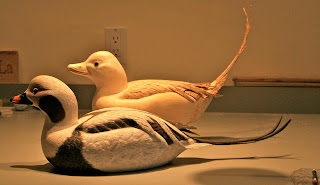My latest project is an
OLDSQUAW DUCK also known as the Long-tailed Duck.
The male has a long pointed tail and a dark grey bill crossed by a reddish/pink band.
This is an earlier carving of that duck.
 |
Old Squaw (Drake) ~ Winter Plumage
|
Unlike most ducks, which molt twice yearly, the Long-tailed Duck has three distinct plumages each year which overlap in partial molts. According to "allaboutbirds.org" the Long-tailed Duck is one of the deepest diving ducks, diving up to 200 feet to forage. It spends more time under water -- three to four times as much as it does on top of the water -- when searching for food.
This new carving will feature the duck in its breeding plumage.
















